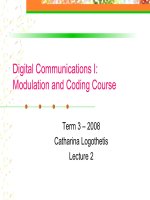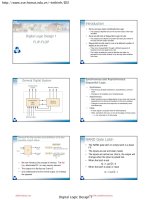Lecture Digital logic design - Lecture 2: More number systems/complements
Bạn đang xem bản rút gọn của tài liệu. Xem và tải ngay bản đầy đủ của tài liệu tại đây (768.92 KB, 59 trang )
Digital Logic Design
Lecture 2
More Number Systems/Complements
1
Overvie
w
° Hexadecimal numbers
• Related to binary and octal numbers
° Conversion between hexadecimal, octal and binary
° Value ranges of numbers
° Representing positive and negative numbers
° Creating the complement of a number
• Make a positive number negative (and vice versa)
° Why binary?
2
Understanding Binary Numbers
°
Binary numbers are made of binary digits (bits):
•
°
How many items does an binary number represent?
•
°
(110.10)2 = 1x22 + 1x21 + 0x20 + 1x2-1 + 0x2-2
Groups of eight bits are called a byte
•
°
(1011)2 = 1x23 + 0x22 + 1x21 + 1x20 = (11)10
What about fractions?
•
°
0 and 1
(11001001) 2
Groups of four bits are called a nibble.
•
(1101) 2
3
Understanding Hexadecimal
Numbers
°
Hexadecimal numbers are made of 16 digits:
•
°
How many items does an hex number represent?
•
°
(2D3.5)16 = 2x162 + 13x161 + 3x160 + 5x16-1 = 723.312510
Note that each hexadecimal digit can be represented
with four bits.
•
°
(3A9F)16 = 3x163 + 10x162 + 9x161 + 15x160 = 1499910
What about fractions?
•
°
(0,1,2,3,4,5,6,7,8,9,A, B, C, D, E, F)
(1110) 2 = (E)16
Groups of four bits are called a nibble.
•
(1110) 2
4
Putting It All
Together
°
Binary, octal, and
hexadecimal similar
°
Easy to build circuits to
operate on these
representations
°
Possible to convert
between the three
formats
5
Converting Between Base 16 and Base
2
3A9F16 = 0011 1010 1001 11112
3
°
A
9
F
Conversion is easy!
Determine 4-bit value for each hex digit
°
Note that there are 24 = 16 different values of four
bits
°
Easier to read and write in hexadecimal.
°
Representations are equivalent!
6
Converting Between Base 16 and Base
8
3A9F16 = 0011 1010 1001 11112
3
352378 =
A
9
F
011 101 010 011 1112
3
5
2
3
7
1. Convert from Base 16 to Base 2
2. Regroup bits into groups of three starting from
right
3. Ignore leading zeros
4. Each group of three bits forms an octal digit.
7
8
Decimal 2 Binary
9
Number systems (Octal
Numbers)
(
Octal Numbers:
[Base 8],[ 0,1,3,4,5,6,7]
Octal to Decimal Conversion:
Example:[2374]8 = [ ? ]10
=4×80+7×81+3×82+2×83
=[1276]10
°Octal number has base 8
°Each digit is a number from 0 to 7
°Each digit represents 3 binary bits
°Was used in early computing, but was
replaced by hexadecimal
10
Number systems (Octal
Numbers)
(
Decimal to Octal Conversion:
The Division:
[359]10 = [ ? ]8
By using the division system:
359 Quotient
44
8
44
5
8
5
0
8
Reminder
7
4
5
5
4
7
11
Number systems (Octal
Numbers)
(
Binary to Octal Conversion:
Example:[110101]2 = [ ? ]8
Here we will take 3 bits and convert it from binary to
decimal by using the decimal to binary truth table:
Decimal
6
101
5
110
6
101
= (65)8
{
110
{
Binary
5
12
Number systems (Octal
Numbers)
(
Octal to Binary Conversion:
Example:[13]8 = [ ? ]2
Here we will convert each decimal digit from decimal
to binary (3 bits) using the decimal to binary truth
table:
Binary
Decimal
1
001
3
011
(13)8
= (001011)2
13
Rad
ix
°Bas
Convert 1234 decimal into octal
ed
Con
ver
sio
n
(Ex
Radix 8
123
am
8
4
ple)
Divide
by radix 8
8 154
8 19
2
2
2
3
Answer
23228
14
Octals
•
•
Converting to decimal from octal:
– Evaluate the power series
Example
2
1
0
2 0 78
2*82
+
0*81
=
+
7*80
13510
15
Hexadecimal
° Hexadecimal is used to simplify dealing with large
binary values:
• Base-16, or Hexadecimal, has 16 characters: 0-9, A-F
• Represent a 4-bit binary value: 00002 (0) to 11112 (F)
• Easier than using ones and zeros for large binary
values
• Commonly used in computer applications
° Examples:
• 11002 = 1210 = C16
• 1010 0110 1100 00102 = A6 C216
Hex values can be followed by an “H” to indicate base-16.
Example: A6 C2 H
16
Hex Values in Computers
17
Decimal to Hexadecimal
Decimal
Hex
0
0
1
1
2
2
3
3
4
4
5
5
6
6
7
7
8
8
9
9
10
A
11
B
12
C
13
D
14
E
15
F
18
Conversion Binary to Hexadecimal
1 0 1 0 1 1 0 0 0 0 0 1 0 1 1 0
1010 = 10
1100 = 12
A
C
0001 = 1
1
0110 = 6
6
19
Rad
ix
°Bas
Convert 1234 decimal into hexadecimal
ed
Con
ver
sio
n
(Ex
Radix 16
am
123
16
4
ple)
Divide
by radix 16
16
77
4
2
D
Answer
4D216
20
Hexadecimals – Base 16
•
•
Converting to decimal from hex:
– Evaluate the power series
Example
2
1
0
2 E A 16
2*162
+
14*161
=
+
10*160
74610
21
Octal to Hex Conversion
To convert between the Octal and Hexadecimal
numbering systems
Convert from one system to binary first
Then convert from binary to the new numbering
system
22
Hex to Octal Conversion
Ex : Convert E8A16 to octal
First convert the hex to binary:
1110 1000 10102
111 010 001 010 and re-group by 3 bits
(starting on the right)
Then convert the binary to octal:
7
2
1
2
So E8A16 = 72128
23
Octal to Hex Conversion
Ex : Convert 7528 to hex
First convert the octal to binary:
111 101 0102 re-group by 4 bits
0001 1110 1010
(add leading zeros)
Then convert the binary to hex:
1
E
A
So 7528 = 1EA16
24
Oct
al to
Hex
adec
imal
Decimal
Octal
Binary
Hexadecimal
25









